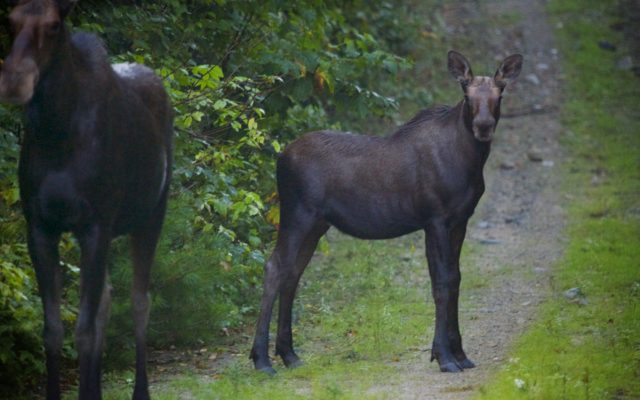
State may try to reduce moose population to reduce tick effects
By John Holyoke, Bangor Daily News Outdoors Editor
Maine wildlife biologists are hoping to launch a research project that will reduce the moose population in a small study area in order to learn if lower population densities will lead to fewer winter ticks on the animals and a healthier overall herd.
The Maine Department of Inland Fisheries and Wildlife is considering splitting Wildlife Management District 4, which stretches west from Baxter State Park to the Quebec border, into two units. The westerly “adaptive” unit would allow the harvest of more moose at the same time the easterly unit maintains the current management strategy.
Over a period of years, the effectiveness of that strategy would be studied, with adjustments made if needed, according to DIF&W moose biologist Lee Kantar.
“We’ll see if [harvesting more moose in half of WMD 4] will impact winter tick numbers over time. Winter tick is the driver of over-winter mortality of calves before they reach their first birthday,” Kantar said. “And it’s also the driver for depressing reproduction in cows, because of the impact they have physiologically on cows in the spring, when they’re pregnant.”
Kantar said a big game management plan unveiled in 2018 called for a new approach to moose. Previously, in much of the animal’s core range in Maine, the department’s goal was to grow the population. Under the new plan, biologists are focused on the health of the herd instead.
“In effect, the whole idea is, if you can reduce the number of ticks out there, break the tick cycle, you’re going to increase the survival of those calves and you’re going to increase the reproductive output of those cows,” Kantar said. “But to do that, you’ve got to lower the population of moose.”
In 2020 he department completed a seven-year study of the effects of winter ticks on moose cows and calves, and learned that the blood loss and anemia caused by the ticks often killed young moose, and led to unhealthy cows.
The new proposal will begin making its way through the DIF&W Advisory Council’s rule-making process after the legislature’s fisheries and wildlife oversight committee is briefed and has a chance to share its thoughts, Kantar said.
If approved by DIF&W Commissioner Judy Camuso after the three-step rule-making process, more moose would be removed from half of the zone through hunting beginning this fall. Kantar said an exact number of additional antlerless permits isn’t known yet, but if approved, those permits would be spread over multiple weeks, not simply added to the existing season structure.
In 2020, a total of 525 moose permits were allotted during two seasons in WMD 4.
A helicopter capture crew from Wyoming’s Native Range Capture Services was in Maine last week, netting and fitting GPS collars on moose in WMD 4. A total of 70 moose were captured, and would bolster the study group of 60 moose caught in the same zone last year.
Kantar said landowners in WMD 4 have expressed their support for the project. The entire WMD covers about 2,000 square miles, or 6 percent of the core range of moose in Maine.
A slow and steady approach to that adaptive project would be key, Kanter said.
“We’ll come up with a number [of additional hunting permits] that we think will help reduce the moose population in that unit, but it’s going to be over time,” Kantar said. “You’re not going to do it all in one fell swoop. The adaptive nature is that none of it is set in stone. We’ll be able to adjust everything as time goes on and we gather more information.”